Cartridge cutlery: Early souvenirs of the Australian War Memorial Museum
During the 1920s and 1930s the Australian War Memorial (known at the time as the Australian War Memorial Museum) needed to raise money to help with the construction of the building here in Canberra. One of the ways the Memorial did this was through the sale of souvenirs made from over ten thousand small arms ammunition cartridges the Australian War Records Section (the precursor to the Memorial) had collected on the Western Front between 1917 and 1919. These cartridges were surplus to exhibition requirements at the time.
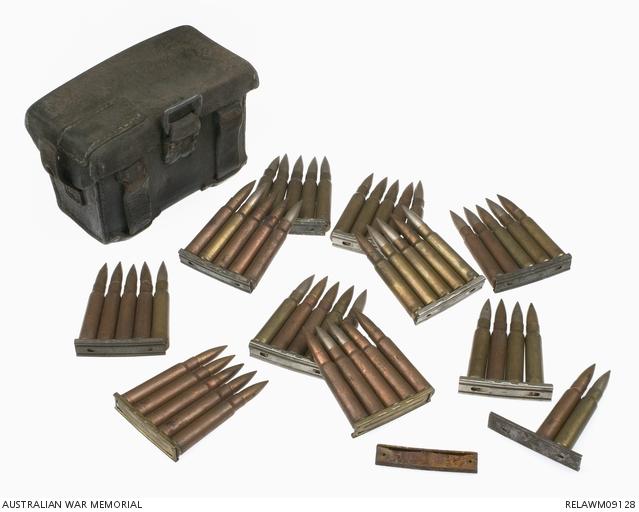
German 7.92mm cartridges, similar to these, were used in making the Memorial souvenirs in the 1920s and 1930s.

Unfortunately little information exists about the creation of these souvenirs, but given the thousands made, it is likely many homes in Australia have some. They are very similar in design to some of the trench art cutlery and paper knives made by soldiers from cartridges during the war and undoubtably these war souvenirs was where the initial idea came from.
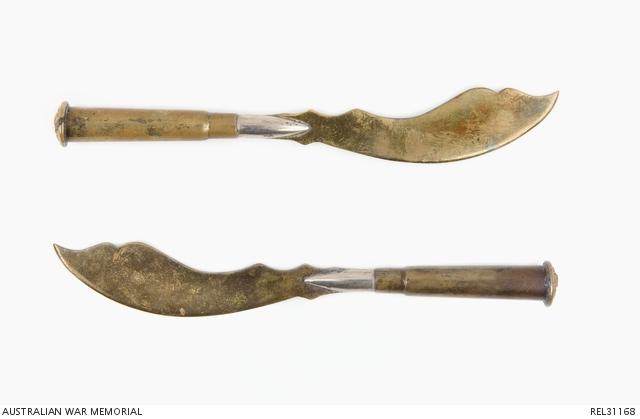
Trench art paper knives from the First World War. These types of items undoubtedly inspired the creation of the souvenir cutlery made by the Australian War Memorial Museum in the 1920s and 1930s.
From what few records are available, it appears they were manufactured in Melbourne by returned servicemen, then either polished and lacquered – to keep the cartridges brass, or plated with nickel in the 1920s, or with silver in the 1930s. The prices varied according to the type, with brass being the cheapest.

Interior of the Australian War Memorial Museum exhibition in Melbourne from 1922 to 1925.
They made a variety of souvenirs from small arms ammunition as shown below. For both the pencil and the nail file, the cartridge was a container to hold the items when not in use - they were among the cheaper souvenirs. The spoons, forks and butter knives were among the most popular. Pickle and bread forks were also sold, but along with the cake forks, they were not as popular as the other items. In today's money, the cheapest individual brass item was the pencil, which if you bought one new today, would cost about $6 each and the most expensive the cake fork, which would cost about $13.50 each. Most of the loose other brass loose cutlery cost around $11 each. The nickel and silver cutlery was more expensive again.
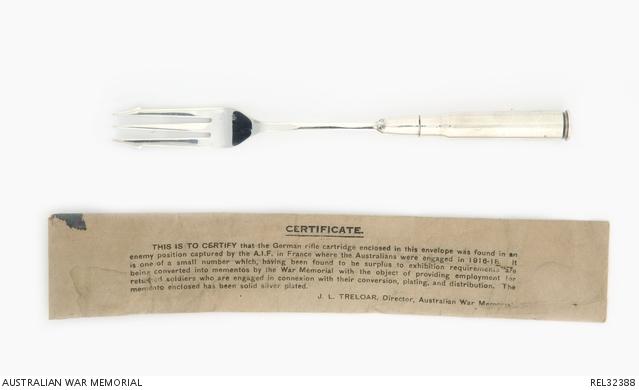
Souvenir pickle fork in original packaging.
The Memorial originally held an exhibition in Melbourne from 1922, before moving to Sydney in1925. They sold many of the souvenirs in Sydney and there is regular correspondence in the files asking for more stock to be sent from Melbourne. It was discovered that the Sydney weather caused the brass souvenirs to tarnish so in 1929 asked staff in Melbourne if they could be supplied with nickel plated items.
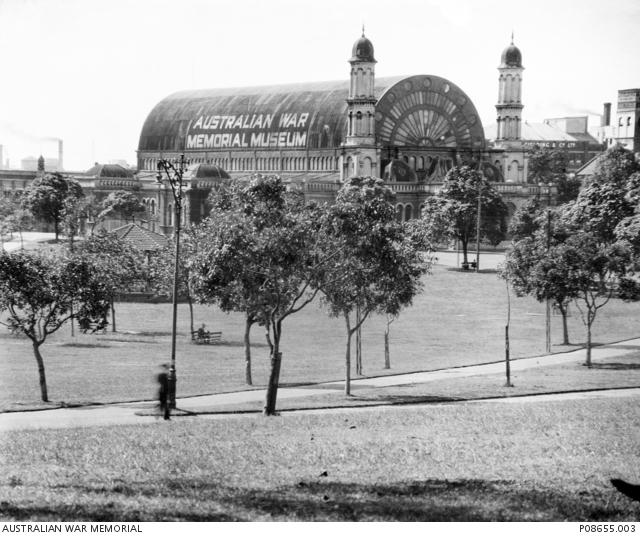
The Australian War Memorial Museum exhibited parts of the collection in the Sydney Exhibition Building in Prince Alfred Park from 1925-1935.
The souvenirs weren’t only sold at the Memorial’s exhibitions in Sydney and Melbourne; salesmen working for the Memorial, and other retailers also received stock to sell. Despite good sales, in March 1928 the Memorial decided not to manufacture any more of these souvenirs. This did not last long as they received so many requests from visitors to the Sydney exhibit for the souvenirs that they decided in July to start making them again.
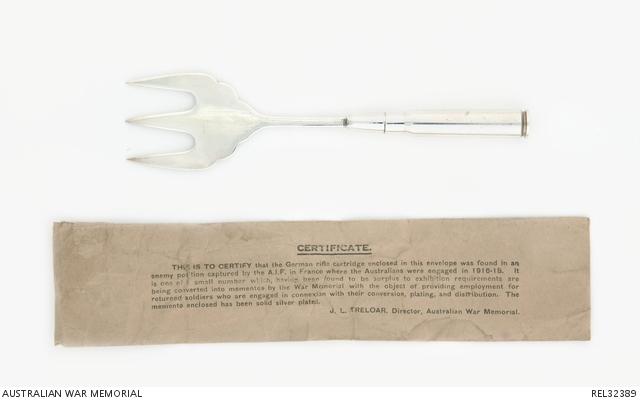
Souvenir cake fork in original packaging.
We have no figures for how many of these types of souvenirs were made. However, a document from 1931 notes that 12,000 rounds of ammunition were sold to be converted into these souvenirs. The souvenirs were either boxed in pairs or sets or sold in special paper envelopes individually. Before 1932 some were sold in teak boxes but this was found to be unprofitable so they changed to a less expensive leatherette case.
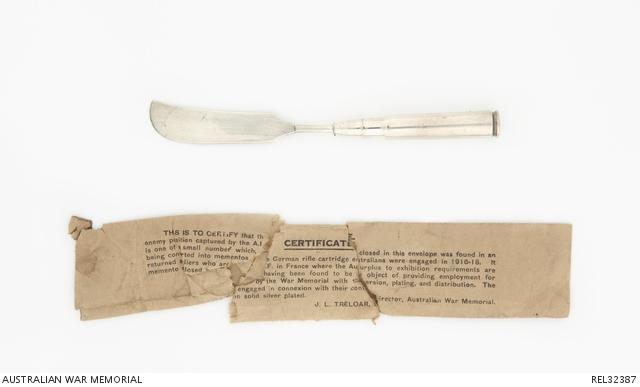
Souvenir butter knife in original packaging.
An interesting aspect of these items is the inconsistency in the look of the souvenirs. While they all have a cartridge for a handle, the actual forks, spoons and knives were acquired in relatively small batches from different suppliers, depending on who had the cheapest items with the right shape to fit into the neck of the cartridges at the time. Several variety retailers, including Coles in Melbourne and Woolworths in Sydney, were sources for the cutlery that were joined with the cartridges to create the Memorial’s souvenirs.
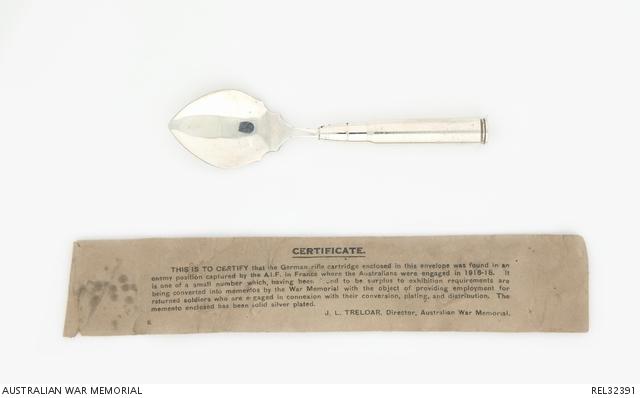
Souvenir jam spoon in original packaging.
How long the Memorial continued to make these souvenirs is unknown. They were still being made in 1932 but they appear to have gone out of production by the time the permanent Memorial building opened in Canberra in 1941.